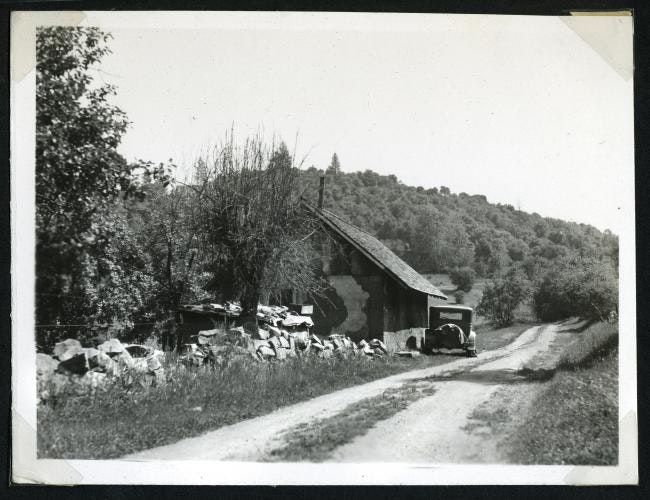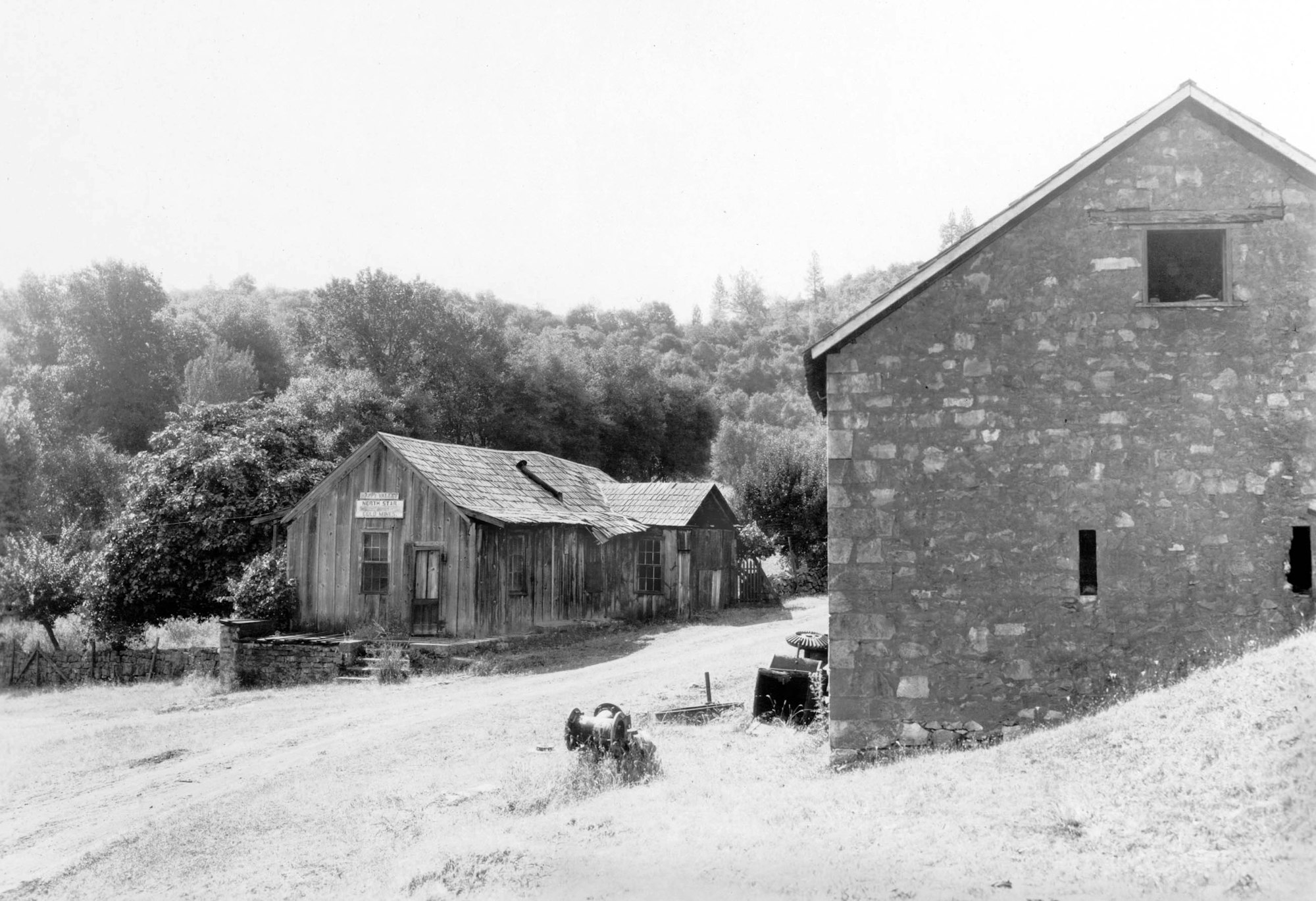Happy Valley

About a mile east of Mokelumne Hill on Highway 26, after you make the tight turn to the right after the Elementary School, the land opens up into a small valley with fields on both sides. This is called Happy Valley and was the location of an early French settlement, extensive placer mining, and winemaking activities.
Although there are tales of French settling in Happy Valley prior to the Gold Rush, this possibility is questionable. Most of the stories can be traced back to Cecile Vandel (Vandelle) who passed on family traditions, and to the writer Lirrel Starling (a Gardella) and Eve Zumwalt who repeated these stories. These stories propose that the pre-Gold Rush pioneers were linked to French Camp (La Forbrois) in the San Joaquin Valley. French Camp was in use between 1830 and 1845, by French Canadians working for the Hudson’s Bay Company. Trapping fur animals - particularly beaver -- common in the Central Valley, these men may have explored up the Mokelumne River. If they had discovered gold and built a settlement at Happy Valley, however, it certainly would have been commented upon by the Argonauts of 1848 and 1849 who swarmed up the area's canyon and tributaries. One group of French miners was noted working near Mokelumne Hill in September of 1848, but these have been identified as being from the ship Noveau Perseverent, at anchor in San Francisco Bay while Captain Boyer mined with half of its crew.
After 1849, emigrants coming from France did congregate in the Happy Valley area where they are well documented in homes, businesses, and mines. The Cretin family members emigrated from France between 1854 and 1856, settling in Calaveras and Tuolumne Counties. Pierre Vandelle came from the same village in France as the Cretins (his mother was a Cretin) and he was writing letters home from Mokelumne Hill by 1852. Louis and Eugene Boudin moved into agriculture, raising grapes and constructing a stone winery in Happy Valley. These families intermarried with other local pioneers and descendants remain in the community today.
In 1854 Joseph Gatenelle was assessed for property consisting of the Happy Valley Hotel known as "Madam Joseph's," operated by his wife Elise. Gatenelle continued to own the property until the 1870s, but by 1860 the business was noted only as a saloon.
Immediately to the east of Gatenelle was the property of Louis and Eugenia Baudin, who arrived in the U.S. in 1853, and by 1856 had established a saloon in the extant adobe in Happy Valley. Their daughter Jennie/Jeanne was born there in 1861, marrying John Meyer in 1885. In the 1860s Baudin’s property was listed as six acres with a saloon. By 1870 he had also planted a vineyard and orchard and had built a stone winery, eventually owning 40 acres in Happy Valley. Louis died in 1888, and his widow, daughter, and son-in-law continued to operate the saloon through 1900, but by 1910 had moved to Stockton with their daughter Alma and Eugenia to operate a lodging house. The Happy Valley property today consists of the ruinous stone winery building, the small adobe, and the large three-compartmented cellar of the no longer extant frame house, with a tunnel leading from the cellar to the winery. It is not known when or by whom the adobe was constructed, but it was probably built by Baudin or one of the early miners of the area.

The Cretin family members emigrated from France between 1854 and 1856, settling in Calaveras and Tuolumne Counties. Pierre Vandelle came from the same village in France as the Cretins (his mother was a Cretin) and he was writing letters home from Mokelumne Hill by 1852. Louis and Eugene Boudin moved into agriculture, raising grapes and constructing a stone winery in Happy Valley. These families intermarried with other local pioneers and descendants remain in the community today.
In 1858 Elizabeth Everest was assessed for the Lafayette Hotel in Happy Valley and a correspondent from the San Andreas Independent, who visited the area in March of that year, stated that "we were surprised to find quite an extensive camp, and at first sight thought we might be mistaken in the place we had so recently left, and thought it possible that Mokelumne Hill had changed her place of residence. Mining here appears to 'play a lively string;’ though having only made a fair start, we hardly deemed it prudent to stop for inquiry." Throughout the period from the 1860s through the 1880s, the settlement consisted of an equal amount of miners and farmers, with several Chinese mining in the area.
Mining activities overwhelmed Happy Valley during the 1850s, 1860s and 1870s when the rich tertiary channels around Mokelumne Hill eclipsed all other mining in northern Calaveras. The ancient river channels, now elevated into ridges, contained abundant placer gold that was recovered through hydraulic mining. Happy Valley was one of the richest locations and extensive remains of washed river cobbles that still cover much of the land attest to the wealth of gold recovered. As much of the land in Happy Valley was hydraulicked, many of the original properties were undoubtedly destroyed by mining activities.
In the early 1900s the North Star Mining Company purchased the Baudin property and in 1906 was assessed for 60 acres and the Crescent Mining Claim consisting of old machinery, wheel, track, etc., also office, house and cabin (the adobe). According to Oswald Lombard, they used the Baudin buildings as their office, etc. but the mining operation was located on the Emerson property to the south and in Old Woman Gulch.
One of the other early settlers of Happy Valley was "Queen Manuela", a Miwok Indian woman who resided in a cabin on the Emerson property near the Mokelumne Hill Ditch up the canyon. The area was an important trade center for the Indians from early times. After the miners, the lands of Happy Valley have settled into the peaceful grazing of cattle and a few residences.
By Judith Marvin, Julia Costello, and Lee Bibb, 2019
References
Bibb, Lee, 2019. Up on the Hill: The Beginnings of a Gold Rush Town, Mokelumne Hill, CA, from 1848 to 1854. Draft manuscript on file with author.
Starling, Lirrel, 1980. Chronicles of Mokelumne Hill I and II.
Vandelle MacMillian, Cecile, various. Correspondence with Willard Fuller, on file at Calaveras County Historical Society, San Andreas, CA.
Zumwalt, Eve, 1990. The Romance of Mokelume Hill. Pioneer Publishing Co., Fresno CA.
